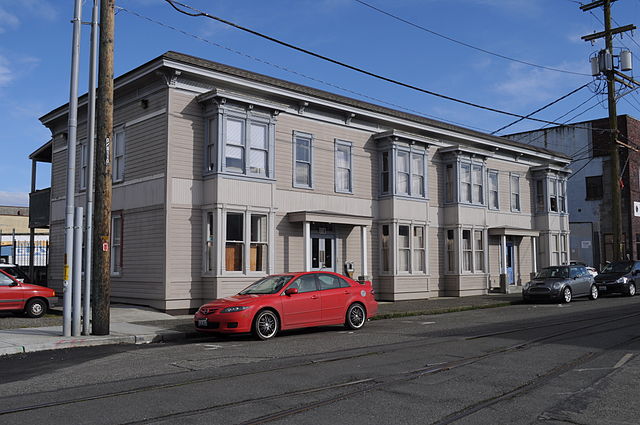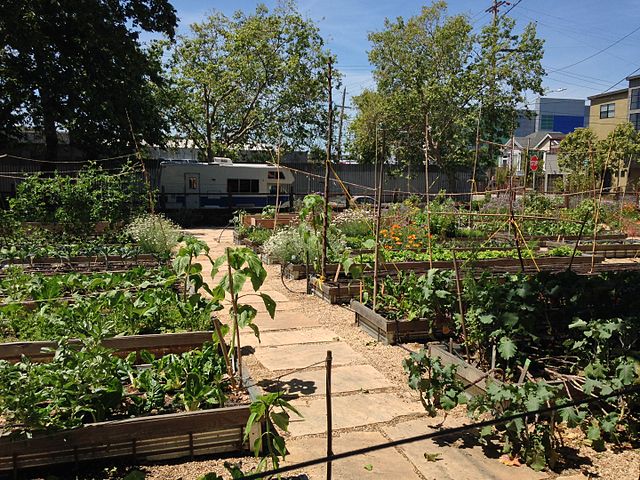4 Things to do with Unused Parking Lots
As part of this year's #BlackFridayParking event, which highlights the negative impacts of parking minimum laws in our towns, we also wanted to talk about what you could do with those parking lots if they weren't mandated as car storage.
The sky is kind of the limit when it comes to making better use of these spaces, but here are four specific examples of how towns across the country are transforming unused parking into more productive developments that offer true benefits to a community, not just temporary car storage:
1. Housing
Create homes for people, not cars.
Housing is a far more economically productive use of space, offering much more value for a community than a parking lot — particularly in cities with increasing housing costs and shortages.
One example of turning a parking garage into housing comes from Redding, California. Community organizations in Redding have proposed demolishing a chronically underutilized downtown parking garage that is at the end of its lifespan and replacing it with a mixed use structure, primarily full of affordable housing, along with retail and some market rate apartments. This effort is happening in tandem with other downtown improvements to make the area more walkable and inviting.
"Right now we have a jobs to housing ratio in our central business district of about 9:1, which is very unbalanced," says Rachel Hatch, Program Officer for Community Vitality at the McConnell Foundation, which is part of this effort. "We really need this shift to happen in order to become a more vibrant place over all."
2. Farming
Turn that lot into productive, nourishing land.
In many ways, parking lots are ripe for farming. Once you get rid of the asphalt and get your soil in order, parking lots are flat land that can swiftly be transformed into food for a neighborhood. One example is the Farmers Assisting Returning Military (F.A.R.M.) organization in Dallas, Texas. This nonprofit transformed an urban parking lot into farmland for their program participants — returning veterans — to work in. Hamilton Farms, which grows produce for several restaurants in St. Louis, Missouri, also began on a former parking lot.
One of the advantages of parking lots turned into farmland is that, unlike housing, which may requires a larger amount of space and probably an entire lot or garage, a farm can occupy just a small portion of a parking lot, if part of the space is still in use for active car parking.
3. Parks
Fill your space with activity, not just asphalt.
Over the last few years, there have been several examples of cities choosing to turn parking into parks. From Santa Monica to Chicago to Dallas, the transition from unused parking lot to active park just makes sense. As with farm plots, parks essentially just need flat, empty land to begin with. In urban areas, where green space is particularly precious and rare, a parking lot is practically guaranteed to produce far more wealth for a community and raise property values than any parking lot or garage ever could.
On a smaller scale, street parking spaces are often transformed into "parklets" (mini parks) temporarily or permanently to offer outdoor seating and additional cafe space. Strong Towns member Paul Fritz spearheaded one of those efforts in Sebastopol, California, which we covered earlier this year.
4. Food Truck Parking
Empower local businesses and activate unused space.
If you can't get rid of a parking lot altogether, you can at least make better use of it by converting a portion of the space into a food truck area. Whether it's just a couple spaces reserved for one truck, several spaces open to multiple trucks, or even umbrellas, chairs and tables for people to sit at while they eat their food, this is a win-win situation. If you own the parking lot, you can rent these spaces out to make a little extra cash and you'll be contributing to a more active street life, as well as potentially drawing in more customers who may be attracted to the food truck options. Food truck operators get a safe place to park and guaranteed foot traffic from the surrounding businesses.
Whenever I'm in Minneapolis visiting my parents and I pass by the city's infamous K-Mart — a massive, barely operating building that cuts off the street grid in an otherwise busy, dense neighborhood — I'm always impressed by the food trucks operating in one corner of the store's enormous and mostly empty parking lot. By all accounts, it's the most active slice of the K-Mart's vast property and I wouldn't be surprised if those few stalls of parking that are utilized by food trucks do more business in a given hour than the K-Mart does. (In fact, I took a trip back in time via Google Maps and found that one particular truck has been a dedicated tenant of the parking lot for more than three years.)
---
In each of these examples, I'm not proposing that we wholesale apply them across every parking lot in a given city. Rather, I'm offering them as ideas to fill under-utilized and vacant lots. Take a little walk around your town and I'd bet anything that you're going to find plenty of empty slices of asphalt that could begin a promising new life as a home or a park.
If we got rid of the parking minimum laws that mandate this wasted space, we could start to turn our communities around and make them into strong towns.





Rachel Quednau serves as Program Director at Strong Towns. Trained in dialogue facilitation and mediation, she is devoted to building understanding across lines of difference. Previously, Rachel worked for several organizations fighting to end homelessness and promote safe, affordable housing at the federal and local levels. Rachel also served as Content Manager for Strong Towns from 2015-2018. A native Minnesotan and honorary Wisconsinite, Rachel received a Masters in Religion, Ethics, and Politics from Harvard Divinity School and a Certificate in Conflict Transformation from the Boston Theological Interreligious Consortium, both in 2020. She currently lives in Milwaukee, Wisconsin, with her husband and young son. One of her favorite ways to get to know a new city is by going for a walk in it.